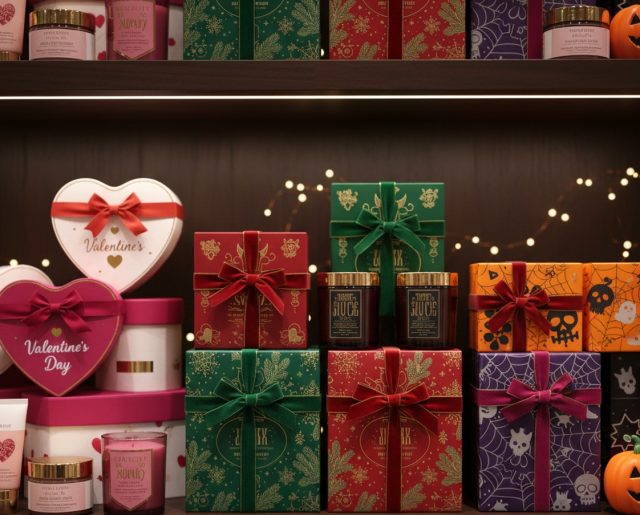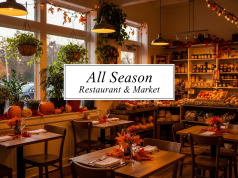Seasonal packaging uses emotion, color psychology, and limited-time appeal to boost visibility and sales. Strategic design, sustainability, and early planning create memorable holiday experiences that strengthen brand loyalty and drive long-term revenue.
The holidays represent the most lucrative time of year for retailers, with consumers spending over $936 billion during the 2022 holiday season alone. Yet many brands miss a critical opportunity to maximize their seasonal sales through strategic packaging design. While competitors rush to slap generic snowflakes or hearts on their products, savvy businesses understand that thoughtful seasonal packaging design can be the difference between a product that gets noticed and one that gets ignored.
Seasonal packaging goes far beyond adding festive colors or holiday symbols. It’s about creating an emotional connection with consumers during moments when they’re most willing to spend. When done correctly, holiday packaging ideas can increase purchase intent by up to 73% and drive significant premium pricing opportunities.
This comprehensive guide explores how to leverage seasonal packaging design to create compelling product presentations that resonate with holiday shoppers, drive sales, and build lasting brand connections during the most competitive time of year.
Understanding the Psychology of Seasonal Packaging
Seasonal marketing taps into powerful psychological triggers that influence purchasing decisions. During holidays and special occasions, consumers experience heightened emotional states that make them more receptive to visual storytelling and symbolic messaging.
Color psychology plays a crucial role in seasonal appeal. Red and green immediately signal Christmas and warmth, while pastels evoke spring renewal and Easter joy. Gold and silver convey premium quality and celebration, making products feel more special and gift-worthy.
Nostalgia also drives holiday purchasing behavior. Packaging that evokes memories of childhood celebrations, family traditions, or cultural heritage creates deeper emotional connections than generic seasonal graphics. This emotional resonance translates directly into increased willingness to pay premium prices.
The concept of limited-time availability adds urgency to seasonal products. When consumers perceive packaging as exclusive to a particular season, it triggers fear of missing out (FOMO) and accelerates purchase decisions.
Strategic Approaches to Holiday Packaging Ideas
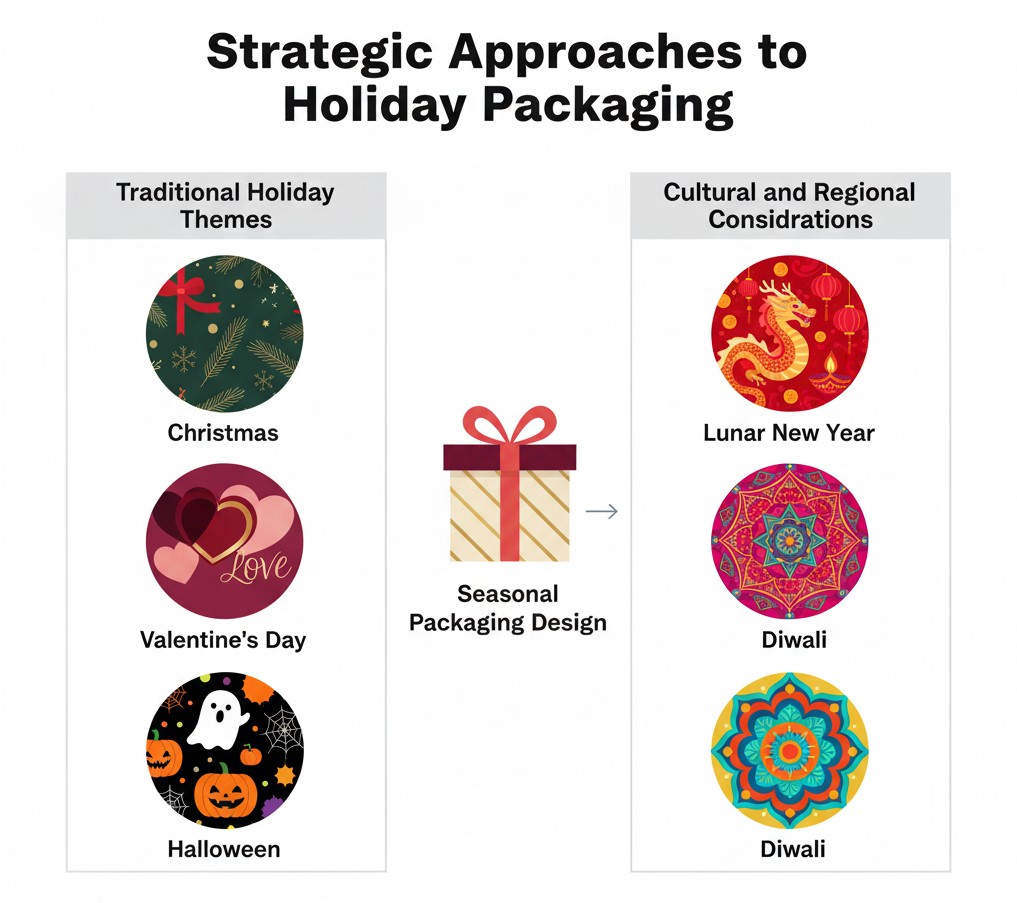
Traditional Holiday Themes
Classic holiday imagery remains effective because it immediately communicates seasonal relevance. However, successful brands elevate traditional themes through sophisticated execution rather than relying on clichéd representations.
Christmas packaging can incorporate evergreen elements, winter wonderland scenes, or religious symbolism while maintaining brand consistency. The key lies in balancing festive appeal with your existing brand identity.
Valentine’s Day packaging benefits from romantic color palettes, heart motifs, and elegant typography that suggest luxury and thoughtfulness. Brands targeting couples often use dual-color schemes that represent partnership and unity.
Halloween packaging allows for creative freedom with bold colors, playful imagery, and interactive elements. Orange and black remain staples, but purple, green, and metallic accents can differentiate products on crowded shelves.
Cultural and Regional Considerations
Successful seasonal packaging design acknowledges diverse cultural celebrations and regional preferences. Brands operating in multicultural markets must consider how different communities celebrate seasons and holidays.
Lunar New Year packaging might emphasize red and gold colors, dragon imagery, and prosperity symbols for Asian markets. Diwali-themed designs could incorporate rangoli patterns, diyas, and vibrant color combinations that resonate with Hindu celebrations.
Regional climate differences also influence seasonal perceptions. Spring packaging that works in temperate climates might feel disconnected in tropical regions where seasons manifest differently.
Custom Product Presentation Strategies
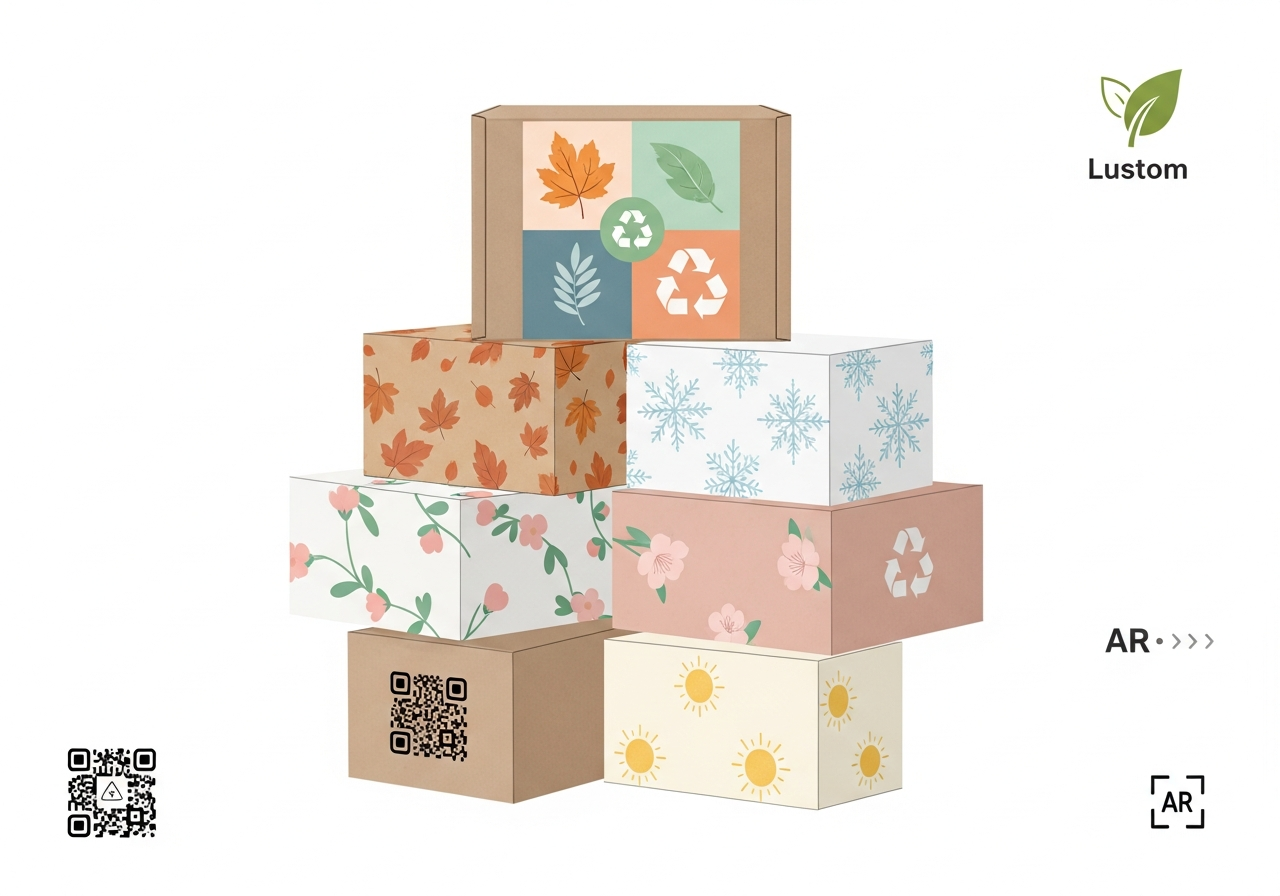
Material Selection and Sustainability
Modern consumers increasingly value environmentally responsible packaging, especially during seasons associated with giving and gratitude. A custom product presentation that incorporates sustainable materials can enhance brand perception while meeting consumer expectations.
Recyclable cardboard, biodegradable films, and plant-based inks allow brands to create stunning seasonal designs without environmental compromise. Some companies use seed-embedded paper that consumers can plant after use, extending the seasonal experience beyond purchase.
Texture adds sensory appeal to seasonal packaging. Embossed patterns, soft-touch coatings, and tactile elements create premium experiences that justify higher price points during gift-giving seasons.
Interactive and Experiential Elements
Packaging that engages multiple senses creates memorable unboxing experiences that consumers share on social media. Hidden messages revealed through temperature changes, augmented reality features activated by smartphone apps, or QR codes linking to seasonal content can transform ordinary packages into marketing assets.
Modular packaging systems allow consumers to repurpose containers for storage or decoration after use. This approach extends brand exposure beyond the initial purchase and aligns with sustainability values.
Limited edition numbering, personalization options, or collectible series elements encourage repeat purchases and create artificial scarcity that drives urgency.
Seasonal Color Psychology and Design Elements
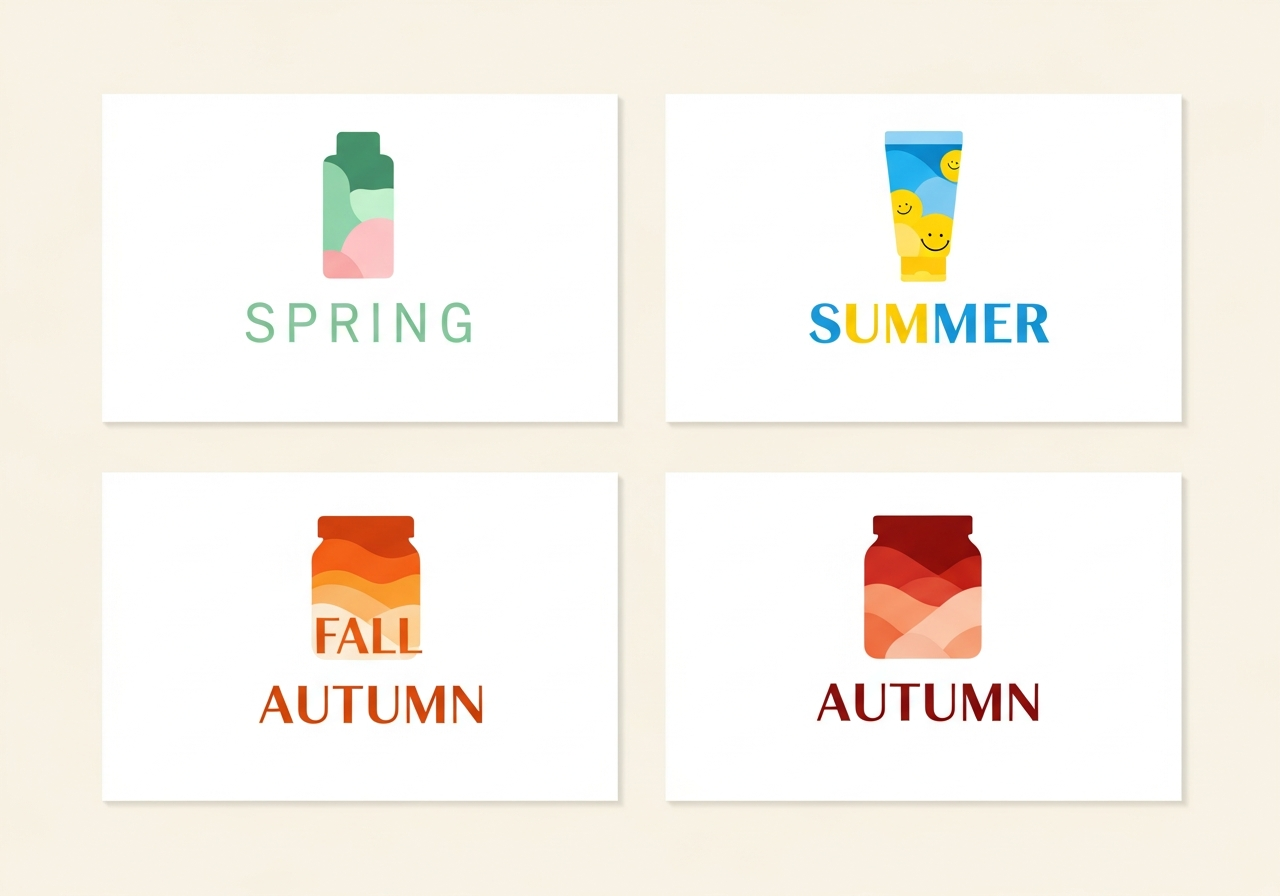
Color Combinations That Convert
Different seasons evoke specific emotional responses through color associations. Spring packaging benefits from fresh greens, soft pinks, and yellow accents that suggest growth and renewal. Summer designs can incorporate bright blues, coral tones, and sunshine yellows that evoke vacation and relaxation.
Fall packaging traditionally uses warm oranges, deep reds, and golden browns that mirror changing leaves and harvest abundance. Winter designs often feature cool blues, crisp whites, and metallic accents that suggest snow and celebration.
However, successful brands sometimes subvert expected color palettes to stand out from competitors. A luxury chocolate brand might use sophisticated black and gold for Christmas instead of traditional red and green, signaling premium positioning.
Typography and Messaging
Seasonal typography should complement your brand’s existing font families while adding festive flair. Script fonts can add elegance to Valentine’s Day packaging, while bold, playful typefaces might suit Halloween products.
Messaging becomes particularly important during gift-giving seasons. Words like “share,” “celebrate,” and “together” resonate more strongly than typical product benefits. Seasonal taglines should feel authentic to your brand voice while acknowledging the holiday context.
Multilingual considerations become crucial for brands serving diverse communities. Seasonal greetings in customers’ native languages demonstrate cultural awareness and inclusion.
Implementation Timeline and Planning
Successful seasonal packaging requires months of advance planning, and it should always align with your broader product marketing strategy. Seasonal campaigns are not just about aesthetics—they must integrate with messaging, promotions, and distribution plans to maximize impact. By incorporating seasonal packaging decisions into your product marketing strategy, brands can ensure that every element—from design to retail placement—supports overarching business goals and drives measurable results.
Seasonal Campaign Development
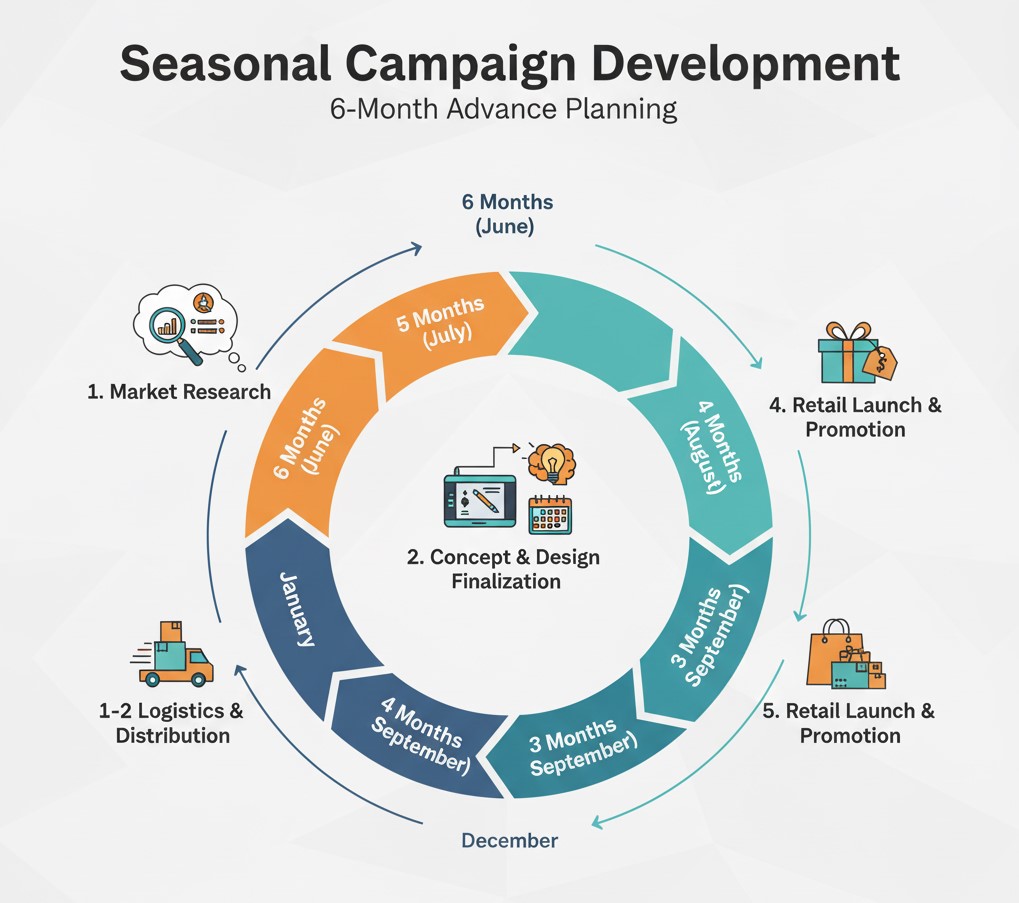
Successful seasonal packaging requires months of advance planning. Christmas packaging decisions typically finalize by August to ensure production and distribution timelines align with retail demand.
Market research should begin at least six months before the target seasons. Consumer surveys, focus groups, and competitor analysis inform design direction and help validate concepts before significant investment.
Cross-functional collaboration between marketing, design, production, and sales teams ensures seasonal packaging aligns with broader campaign strategies and operational capabilities.
Production and Logistics Considerations
Seasonal demand creates production challenges that require careful coordination. Print facilities often experience capacity constraints during peak seasons, potentially affecting lead times and costs.
Inventory management becomes critical with seasonal products. Overproduction leads to costly disposal, while underproduction means missed sales opportunities. Historical data and predictive analytics help optimize production quantities.
Distribution timing affects retail relationships and consumer satisfaction. Products arriving too early may lose seasonal relevance, while late deliveries miss crucial selling periods.
Consumer Behavior Trends Shaping the Future of Seasonal Packaging
Modern consumers are redefining what effective seasonal packaging looks like, pushing brands to focus on experience, sustainability, and shareability. Understanding these behaviors is critical when developing a strong seasonal marketing strategy.
Today’s shoppers want packaging that not only looks festive but also delivers emotional value, environmental responsibility, and digital engagement. By aligning packaging decisions with your seasonal marketing strategy, brands can ensure each product resonates with target audiences while maximizing campaign effectiveness
Key Consumer Trends:
- Experience-Driven Purchases: Shoppers prefer packaging that feels premium, gift-ready, and exciting to open.
- Social Media Influence: Visually striking “share-worthy” packaging boosts organic exposure on TikTok, Instagram, and YouTube.
- Eco-Conscious Decision-Making: Consumers increasingly favor recyclable, reusable, or minimal-waste seasonal materials.
- Personalization Demand: Custom names, messages, and limited-edition themes increase emotional attachment.
- Transparency Expectations: Clear communication of sustainability practices improves trust and brand loyalty.
Consumer Trend Impact Table
| Trend | What Shoppers Expect | How Brands Should Respond | Benefits |
|---|---|---|---|
| Experience-Driven Buying | Premium feel, unique unboxing | Add textures, layered unwrapping, premium finishes | Higher perceived value, gift appeal |
| Social Media Influence | Photogenic, bold designs | Use high-contrast colors, unique shapes | Increased virality & UGC |
| Sustainability Focus | Eco-friendly materials | Use recycled cardboard, plant-based inks | Stronger brand trust |
| Personalization | Custom names or seasonal variants | Offer variable printing, personalized labels | Emotional connection, giftability |
| Transparency | Clear sustainability messaging | Add icons, QR codes with details | Credibility & loyalty |
By embracing these consumer-driven trends, brands can create seasonal packaging that not only stands out on shelves but also resonates emotionally, performs well on social channels, and aligns with modern values—ultimately driving stronger seasonal sales and year-round brand loyalty.
Measuring Success and ROI
Key Performance Indicators
Sales lift represents the most direct measure of seasonal packaging effectiveness. Comparing performance periods with and without seasonal designs provides clear ROI calculations.
Brand awareness metrics during seasonal periods indicate whether packaging successfully increased visibility and recall. Social media engagement rates often spike when consumers share attractive seasonal packaging experiences.
Customer acquisition costs may decrease during seasons when effective packaging drives organic word-of-mouth marketing and social sharing.
Long-term Brand Impact
Seasonal packaging can influence brand perception beyond immediate sales periods. Consumers often associate positive seasonal experiences with brands, creating loyalty that extends throughout the year.
Premium positioning established through high-quality seasonal packaging can support year-round pricing strategies and elevate overall brand value.
Market share gains during competitive seasons may establish advantages that persist as consumer habits solidify around preferred brands.
Creating Lasting Holiday Connections
Seasonal packaging design represents far more than temporary marketing tactics. When executed strategically, it builds emotional connections that extend well beyond individual holiday periods. The brands that succeed understand that seasonal appeal isn’t about following trends—it’s about authentically connecting with customers during moments when emotions run high and purchase intent peaks.
Start planning your next seasonal campaign today. Begin with consumer research to understand what resonates with your specific audience during different seasons. Test small-scale concepts before committing to large production runs, and always maintain the brand elements that make your products recognizable year-round.
Remember that the most effective seasonal packaging tells a story that aligns with both the holiday spirit and your brand values. When these elements work together harmoniously, seasonal packaging becomes a powerful tool for driving sales, building loyalty, and creating the kind of memorable experiences that turn seasonal shoppers into year-round advocates.
Frequently Asked Questions
1. How far in advance should brands plan seasonal packaging campaigns?
Most successful seasonal campaigns begin planning 6-8 months before launch. This timeline allows adequate time for market research, design development, production setup, and distribution coordination. Christmas campaigns typically start planning in May, while Valentine’s Day preparations begin in September.
2. What budget allocation is recommended for seasonal packaging design?
Industry benchmarks suggest allocating 15-25% of total seasonal marketing budgets to packaging design and production. However, this varies significantly by industry, with luxury goods often investing higher percentages due to the importance of premium presentation.
3. How can small businesses compete with larger brands’ seasonal packaging budgets?
Small businesses can leverage digital printing technologies for smaller runs, partner with local artists for unique designs, and focus on authentic storytelling that resonates with niche audiences. Emphasizing handcrafted elements or local community connections often creates more meaningful connections than expensive production techniques.
4. Should seasonal packaging completely override brand identity?
Never completely abandon core brand elements for seasonal appeal. The most successful seasonal packaging maintains brand recognition while incorporating holiday themes. Consistent logo placement, brand colors as accent elements, and familiar typography help maintain brand equity.
5. How do cultural sensitivities affect seasonal packaging decisions?
Brands must research the cultural significance of colors, symbols, and themes in target markets. What appears festive in one culture may be inappropriate or offensive in another. When in doubt, focus on universal themes like celebration, gratitude, and togetherness rather than specific religious or cultural symbols.
6. What role does sustainability play in seasonal packaging design?
Sustainability has become a crucial factor, especially during seasons associated with giving and gratitude. Consumers increasingly expect eco-friendly packaging options. Brands can use recyclable materials, minimize packaging waste, and clearly communicate environmental benefits to meet these expectations.
7. How can brands measure the specific impact of seasonal packaging on sales?
Implement A/B testing by using seasonal packaging in select markets while maintaining standard packaging in control markets. Track sales performance, customer acquisition rates, and brand awareness metrics across both groups. Additionally, monitor social media engagement and user-generated content featuring seasonal packaging.
Learn more about: Building a Product Marketing Strategy for a New Market Entry

